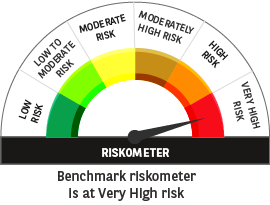AUM
₹ 1738.49 Crores
Benchmark
BSE 250 Large & Midcap TRI
Inception Date
04-09-2020
Expense Ratio (Base)
1.93%
As on 07-01-2026
Bars show Return distribution (% of times) in a given range for a selected time period.

1 year |
3 years |
5 years |
Since inception |
|
|---|---|---|---|---|
| Regular Plan (% CAGR*) | 0.86% | 17.72% | 20.08% | 21.53% |
| Direct Plan (% CAGR*) | 2.15% | 19.26% | 21.82% | 23.31% |
| BSE 250 Large & Midcap TRI (% CAGR*) | 7.55% | 14.95% | 18.24% | 20.36% |
| Additional Benchmark Nifty 50 TRI (% CAGR*) | 9.97% | 13.11% | 16.50% | 18.75% |
| Value of ₹10,000 Invested In | 1 year |
3 years |
5 years |
Since inception |
|---|---|---|---|---|
| Regular Plan | 10085.94 | 16306.67 | 24949.87 | 27754.90 |
| Direct Plan | 10214.81 | 16953.13 | 26811.05 | 29958.10 |
| BSE 250 Large & Midcap TRI | 10753.04 | 15184.93 | 23096.37 | 26384.76 |
| Additional Benchmark Nifty 50 TRI | 10993.65 | 14466.04 | 21454.83 | 24593.93 |
Past performance may or may not be sustained in future and is not a guarantee of any future returns. Returns do not take into account the load, if any. Returns are for growth option. Different plans shall have a different expense structure. The performance details provided above are for regular/distributor plan.
Please refer below for fund manager details and performance of other funds managed by the Fund Manager(s)
*Compound annual growth rate
**Benchmark & ***Additional Benchmark
Data As on 30th November 2025 or specified otherwise.
1 YRS CAGR |
3 YRS CAGR |
5 YRS CAGR |
Since Inception |
|
|---|---|---|---|---|
| Scheme Return (% CAGR*) (Regular) | 11.34% | 15.64% | 17.15% | 17.35% |
| BSE 250 Large & Midcap TRI (% CAGR*) | 16.01% | 15.28% | 15.35% | 16.03% |
| Scheme Return (% CAGR*) (Direct) | 12.76% | 17.18% | 18.79% | 18.71% |
| Value of ₹10,000 Invested In | 1 YRS |
3 YRS |
5 YRS |
Since Inception |
|---|---|---|---|---|
| Amount Invested (Regular) | 120,000.00 | 360,000.00 | 600,000.00 | 620,000.00 |
| Market Value At Month End (Regular) | 127,139.00 | 453,475.00 | 919,835.00 | 980,938.00 |
| Amount Invested (Direct) | 120,000.00 | 360,000.00 | 600,000.00 | 620,000.00 |
| Market Value At Month End (Direct) | 128,011.00 | 463,461.00 | 957,204.00 | 1,003,452.00 |
Past performance may or may not be sustained in future and is not a guarantee of any future returns. Returns do not take into account the load, if any. Returns are for growth option. Different plans shall have a different expense structure. The performance details provided above are for regular/distributor plan.
Please refer below for fund manager details and performance of other funds managed by the Fund Manager(s)
*Compound annual growth rate
Data As on 2025-11-28 specified otherwise.

This calculator is provided for informational purposes only.
The results are based on user inputs and should not be considered as investment advice. Users should seek the advice of a qualified financial professional before making any investment decisions.
The creators of the calculator and its affiliates shall not be held responsible for any financial losses resulting from the use of the calculator.
Past performance may or may not be sustained in the future and should not be used as a basis for comparison with other investments. Mutual Fund Investments are subject to market risks, read all scheme related documents carefully.
SIP is allowed in select open ended schemes. Refer the Scheme SAI, SID, KIM for detailed information


Fund BARODA BNP PARIBAS ELSS Tax Saver Fund - Regular - Growth Option
Frequency Monthly
SIP Start Date 05-01-2006
SIP End Date 01-01-2025
Invested Amount ₹22,80,000.00
Current Value ₹1,03,86,141.98
Scheme Returns 14.17%
Benchmark Returns 14.12%
TER (Total Expense Ratio) 2.2%
This calculator is provided for informational purposes only.
The results are based on user inputs and should not be considered as investment advice. Users should seek the advice of a qualified financial professional before making any investment decisions.
The creators of the calculator and its affiliates shall not be held responsible for any financial losses resulting from the use of the calculator.
Past performance may or may not be sustained in the future and should not be used as a basis for comparison with other investments. Mutual Fund Investments are subject to market risks, read all scheme related documents carefully.
SIP is allowed in select open ended schemes. Refer the Scheme SAI, SID, KIM for detailed information
The primary objective of the Scheme is to seek long term capital growth through investments in both large cap and mid cap stocks. However, there can be no assurance that the investment objectives of the Scheme will be realized. The Scheme does not guarantee/indicate any returns.
Entry Load : Not Applicable
Exit Load: Upto 365 days · Redeemed or switched out upto 10%
of the allotment: Nil · Redeemed or switched out more than
10% of the allotment: 1% After 365 days - Nil
Lumpsum Details:
Minimum Application Amount: ₹5,000 and in multiples of ₹1 thereafter.
Minimum Additional Application Amount: ₹1,000 and in multiple of ₹1 thereafter
(i) Daily, Weekly, Monthly SIP: ₹ 500/- and in multiples of ₹ 1/- thereafter; (ii) Quarterly SIP: ₹ 1500/- and in multiples of ₹ 1/- thereafter. There is no upper limit
₹ 1000/Installment - 6 Installments - Frequency - Daily/Weekly/Fortnightly/Monthly/
₹ 1500/Installment - 4 Installments - Frequency - Quarterly
Withdrawal must be for a minimum amount of ₹ 1,000/- or in multiples of Re.1/- thereafter, in Weekly / Monthly SWP and ₹ 1,500/- and in multiples of Re.1/- thereafter, in Quarterly SWP.
An open ended equity scheme investing in both large and mid-cap stocks
This product is suitable for investors who are seeking*:
- Capital appreciation over long term.
- Investment predominantly in equity and equity related instruments of large and midcap stocks.


^^Riskometer For Scheme: basis it's portfolio, ^Riskometer For Benchmark (BSE 250 Large & Mid Cap TRI): basis it's constituents; as on December 31, 2025
*Investors should consult their financial advisers if in doubt about whether the product is suitable for them.
Information Ratio (IR) is a risk adjusted return metric which helps investors understand whether the Scheme has generated excess return over the benchmark index consistently. It is often used as a measure of a portfolio manager's level of skill and ability to generate excess returns, relative to a benchmark and attempts to identify the consistency of the performance by incorporating standard deviation into the calculation.
When a portfolio's IR is high, it indicates that it is performing well, meaning that it consistently produces risk adjusted returns. In contrast, a low IR may indicate a volatile portfolio, which means the portfolio generates less predictable returns.
As per the methodology of calculation mentioned in the circular by SEBI regarding disclosure of IR, daily portfolio return shall be calculated using arithmetic function, and the standard deviation will be calculated based on these daily return values. IR would be calculated for 1-year, 3-year, 5-year, and 10-year horizon using this methodology.
Ideally one would prefer a portfolio which earns stable returns, over one which generates less consistent returns. Information ratio becomes useful here. Consider that you need to invest in 1 of 3 portfolios – a steady growth fund A, a volatile investment B, and a fund underperforming the benchmark C. We’ll assume that the benchmark index has given an average return of 14%. Here’s how Information Ratio can help make an investment decision -
| Portfolio | A | B | C |
|---|---|---|---|
| Portfolio’s Return (1) | 17% | 20% | 12% |
| Benchmark Return (2) | 14% | 14% | 14% |
| Tracking Error (3) | 4% | 10% | 3% |
|
IR [(1)-(2)] / (3) |
0.75 | 0.60 | -0.67 |
Hence even though portfolio B has delivered better absolute returns compared to portfolio A, for a risk averse investor, portfolio A would be preferable. The example also illustrates that the IR may be negative, in the scenario that the Scheme has underperformed its benchmark.

Sanjay Chawla
Chief Investment Officer Equity (CIO-Equity)
Managing this fund since September 2020
Performance of Other Funds Managed by Sanjay Chawla
Kirtan Mehta
Senior Analyst
Managing this fund since January 2025
Performance of Other Funds Managed by Kirtan Mehta
An open ended equity scheme investing in both large and mid-cap stocks
Equity
₹ 27.8854
NAV as on 07-01-2026

21.53 %
Returns lumpsum
17.35%
Returns SIP
| Schemes (Benchmark Index) | 1 Year CAGR | 3 Year CAGR | 5 Year CAGR | |||
|---|---|---|---|---|---|---|
| Scheme Returns | Benchmark Returns | Scheme Returns | Benchmark Returns | Scheme Returns | Benchmark Returns | |
| Baroda BNP Paribas Balanced Advantage Fund (NIFTY 50 Hybrid Composite Debt 50:50 Index) | 7.65% | 14.15% | 13.98% | 8.39% | 13.32% | 10.41% |
| Baroda BNP Paribas Banking and Financial Services Fund (Nifty Financial Service TRI) | 14.04% | 12.79% | 16.23% | 17.36% | 15.64% | 14.08% |
| Baroda BNP Paribas ELSS Tax Saver Fund (Nifty 500 TRI) | 5.59% | 11.96% | 18.71% | 6.58% | 17.96% | 15.61% |
| Baroda BNP Paribas Flexi Cap Fund (Nity 500 Total Return Index) | 2.66% | 15.38% | 15.64% | 6.58% | N.A.* | 15.61% |
| Baroda BNP Paribas Focused Fund (Nifty 500 TRI) | 2.43% | 10.52% | 13.90% | 6.58% | 15.42% | 15.61% |
| Baroda BNP Paribas Large and Mid Cap Fund (BSE 250 Large & Midcap TRI) | 0.86% | 21.53% | 17.72% | 7.55% | 20.08% | 14.95% |
| Baroda BNP Paribas Multi Cap Fund (Nifty 500 Multicap 50:25:25 TRI) | 0.02% | 15.28% | 18.40% | 4.78% | 20.83% | 17.99% |
| Baroda BNP Paribas Small Cap Fund (Nifty Small Cap 250 TRI ) | -4.04% | 13.19% | N.A.* | -5.03% | N.A.* | N.A.* |
Period for which scheme's performance has been provided is computed basis last day of the month-end preceding the date of advertisement.
Past performance may or may not be sustained in future and should not be used as a basis of comparison with other investments. Returns do not take into account the load, if any. Returns are for growth option. Different plans shall have a different expense structure. The performance details provided above are for regular/distributor plan.
For Fund Manager(s) & Managing Since Details click here
*Where returns are not available for that particular period, they have not been shown.
| Schemes (Benchmark Index) | 1 Year CAGR | 3 Year CAGR | 5 Year CAGR | |||
|---|---|---|---|---|---|---|
| Scheme Returns | Benchmark Returns | Scheme Returns | Benchmark Returns | Scheme Returns | Benchmark Returns | |
| Baroda BNP Paribas Flexi Cap Fund (Nity 500 Total Return Index) | 2.66% | 15.38% | 15.64% | 6.58% | N.A.* | 15.61% |
| Baroda BNP Paribas Focused Fund (Nifty 500 TRI) | 2.43% | 10.52% | 13.90% | 6.58% | 15.42% | 15.61% |
| Baroda BNP Paribas Large and Mid Cap Fund (BSE 250 Large & Midcap TRI) | 0.86% | 21.53% | 17.72% | 7.55% | 20.08% | 14.95% |
| Baroda BNP Paribas Multi Cap Fund (Nifty 500 Multicap 50:25:25 TRI) | 0.02% | 15.28% | 18.40% | 4.78% | 20.83% | 17.99% |
Period for which scheme's performance has been provided is computed basis last day of the month-end preceding the date of advertisement.
Past performance may or may not be sustained in future and should not be used as a basis of comparison with other investments. Returns do not take into account the load, if any. Returns are for growth option. Different plans shall have a different expense structure. The performance details provided above are for regular/distributor plan.
For Fund Manager(s) & Managing Since Details click here
*Where returns are not available for that particular period, they have not been shown.